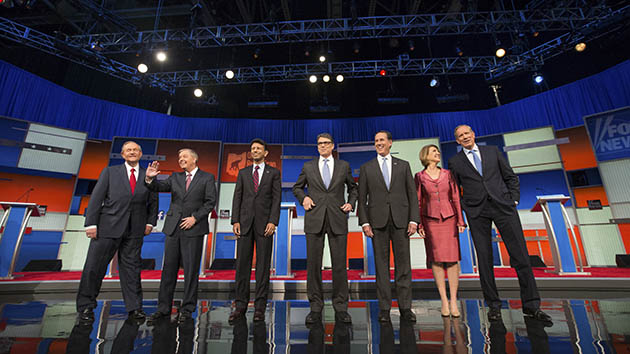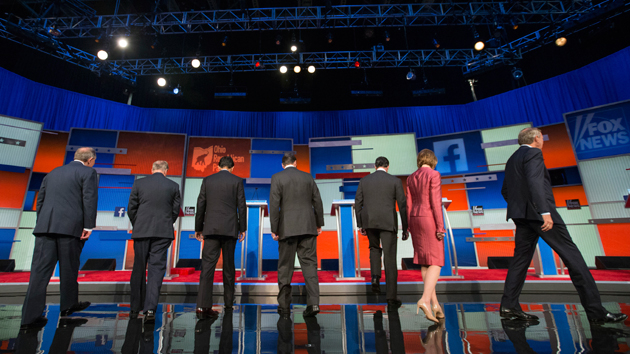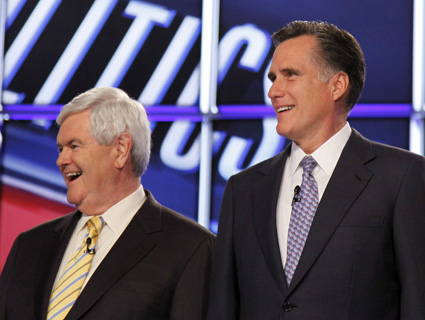
Republican presidential candidates from left, Jim Gilmore, Lindsey Graham, Bobby Jindal, Rick Perry, Rick Santorum, Carly Fiorina, and George Pataki take the stage for a pre-debate forum at the Quicken Loans Arena, Thursday, Aug. 6, 2015, in Cleveland. Seven of the candidates have not qualified for the prime time debate.Andrew Harnik/AP
Fox News raised hackles when it announced the selection criteria for the first GOP presidential candidate debate: only the top-10, based on an average of selected national polls, would be allowed into the primetime debate. Rick Santorum called it “preposterous,” but Fox had a solution. It would put on a pre-debate debate a couple hours before the main event, featuring the candidates that weren’t quite fit for prime time. It wasn’t a perfect solution, but at least they’d get a chance to air their views. But it was quickly clear that these were second-tier candidates, at least based on the way moderators Martha MacCallum and Bill Hemmer framed the early questions:
First question, essentially: aren’t you a loser whose time has long passed. #FoxKiddieDebate
— David Corn (@DavidCornDC) August 6, 2015
Summary of #kidstable so far: Who are you? Why are you a loser? What about Donald Trump, who is a winner? Who should we bomb, and how much?
— Peter Suderman (@petersuderman) August 6, 2015
The B-team feel was also reinforced by a largely-empty Quicken Loans Arena:
— Chris Cillizza (@TheFix) August 6, 2015
FYI this second-tier debate will be applause-free because there’s pretty much nobody here except reporters.
— Sahil Kapur (@sahilkapur) August 6, 2015
He said it in an empty theater https://t.co/PALLWrSjzO
— Glenn Thrush (@GlennThrush) August 6, 2015
But that’s not to say the candidates didn’t say interesting things. There were flubs:
seen in the wild: rick perry’s “ronald raven” pic.twitter.com/dZONFpzxXf
— Oliver Willis (@owillis) August 6, 2015
And a sleepy Sen. Lindsey Graham saying some rather interesting things about women’s rights:
Lindsey Graham’s Answer on Abortion: Come with Me to the Middle East http://t.co/0V54lfIRYn (VIDEO) pic.twitter.com/B60a6gwgCH
— Mediaite (@Mediaite) August 6, 2015
Ladies, you’re better off with us than the Taliban so why don’t y’all just keep it down.
— jess mcintosh (@jess_mc) August 6, 2015
But maybe that paid off?
Google searches for Lindsey Graham demolished searched for Trump. http://t.co/E2HW1esVbA pic.twitter.com/1bHq6X8jVf
— Philip Bump (@pbump) August 6, 2015
Rick Santorum also had some interesting things to say, although not in the way he probably wanted:
Thanks for this, Rick Santorum pic.twitter.com/ylXdniEHFA
— Rob Tornoe (@RobTornoe) August 6, 2015
Rick Santorum: “How optimistic about America am I? My wife and I COULD NOT STOP COPULATING.”
— Jeff B@AoSHQDD (@EsotericCD) August 6, 2015
The question the candidates had the most difficulty with was providing a two-word description of Hillary Clinton:
Number of words the candidates used for their “2-word answers”: PATAKI: 9 FIORINA: 4 SANTORUM: 3 PERRY: 3 JINDAL: 4 GRAHAM: 11 GILMORE: 6
— Molly Ball (@mollyesque) August 6, 2015
But Carly Fiorina emerged the clear winner:
Carly Fiorina the Runaway Winner of Fox News JV Debate #GOPDebate #CarlyFiorina http://t.co/cqBhKZHwAR
— reason (@reason) August 6, 2015
Carly, after this debate. pic.twitter.com/fsSMakCpoF
— Chris Cillizza (@TheFix) August 6, 2015
She might have been the only one to really move the needle, as most of the candidates will likely continue to poll in the low single digits:
While Fiorina delivered a relatively strong performance, the second-tier GOP candidates struggled to break through http://t.co/SAg7iLuNiu
— POLITICO (@politico) August 6, 2015
Glad that’s overwith, or…
OK! The first debate night is done. Have a great night everyb-Wait, what? Oh, s**t
— Ron Fournier (@ron_fournier) August 6, 2015















